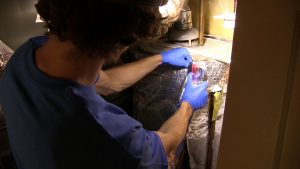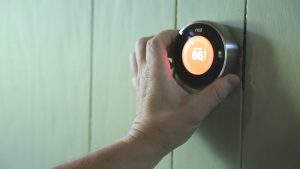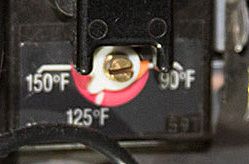Story and photos by Adam Sheffield
The inevitable colder temperatures of winter can lead to rising energy costs — is your home ready? To help you prepare, Appalachian Voices recently produced several short videos where energy efficiency experts demonstrate ways to lower your home’s energy use. These straightforward upgrades can lower your energy bill as well as help you protect the environment by consuming less energy.
Below are several tips and energy-saving projects from the “Heating and Cooling” and “Water Heating” videos that you can do yourself.
To watch instructional videos about these and other home energy efficiency projects, visit appvoices.org/energy-diy
Heating & Cooling
John Kidda of reNew Homes, Inc., in Boone, N.C., discusses the energy saving benefits of using programmable thermostats as a way to save on heating and cooling bills.
Programmable thermostats allow residents to set the temperature in their home based on their schedule, removing the need to leave the air conditioner or heat running on high while away at work or asleep. During winter, set the thermostat to a lower temperature while you’re away from home or in bed, and program your thermostat to increase the heat right before you normally come home or wake up. Some thermostats can even be adjusted from a mobile device.
Kidda points out that when a home is properly insulated and air leakage is minimized, the thermostat can be set to lower temperatures because heat is not being lost. “One interesting thing is that once you better insulate a house and make it less drafty, you actually will feel more comfortable at a lower temperature,” Kidda says.
Insulation & Air Leakage
Harper Robinson, project manager with Conservation Pros in Asheville, N.C., demonstrates proper installation of crawl space insulation and sealing of attic drafts in this video. According to Robinson, insulation should be positioned with the paper side facing the direction you want to keep warm. Insulation can be held in place by using short metal rods between joists in the crawl space. Robinson also applies a spray foam sealant to an attic’s gaps and crevices, inhibiting air from escaping the finished areas of the home.
Water Heaters
Keeping a home’s water heater at an appropriate temperature is a simple way to save energy. Remove the tank’s small access panel and locate the temperature dial. Adjust the dial up or down with a small coin or screwdriver. Optimal temperature settings release shower and tap water that is hot to the touch without having to be diluted with cold water. When temperatures are too high, the tank uses more energy to maintain consistently hot water and risks scalding skin. But water heaters should be set to at least 120 degrees Fahrenheit to avoid bacterial growth inside the tank.
Robinson explains that wrapping your tank with an insulation blanket can maintain heat within. Another way to retain warm water is to wrap the first few feet of pipe coming out of the tank with pipe-specific insulating material, such as foam tubing or insulation strips.
Related Articles
Latest News

Leave a comment
Your email address will not be published. Required fields are marked *








